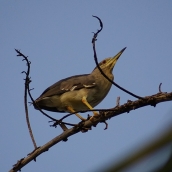Black-crowned Night Heron (Nycticorax nycticorax)
This marsh-dweller measures up to 58-65 cm, with a wingspan of 90-100 cm. Plumage differs considerably according to age. Adults have grey, blackish-blue backs, with a black cap and fine white feathers on the head that develop in the breeding season. Juveniles are brown, with pale spots dotted over the back and wings, in particular. The bill is straight and stout. The call is similar to a slight croak, hence the scientific name, which can be translated as ‘night-raven’. The heron’s large crimson or yellowish (depending on age) eyes facilitate its nocturnal activities. In Macaronesia it breeds in the Canaries, specifically in Tenerife and Gran Canaria, and is only seen in the other island groups (except the Savage Islands) during the migratory season. A frequent visitor to Cape Verde, it is seldom seen in the Azores and Madeira. Migrating individuals also make the occasional appearance in Lanzarote and its islets, Fuerteventura, La Gomera, La Palma and El Hierro. It lives in pools and lagoons with more or less dense marginal vegetation, such as reed beds, although during migration it can be seen in ravines with running water, as occurs in Fuerteventura. It mainly feeds on amphibians, fish and insects on the edges of wetlands, often from a static position (e.g., perched on a waterside reed). Only recently has it been confirmed as breeding in the Canaries: southwest and northwest Tenerife, in 2002 and 2003, respectively, and north Gran Canaria, in 2008. Its expansion to new areas and other Canary Islands, as well as other island groups (e.g., Madeira and Cape Verde) is highly likely, due to the existence of suitable habitats. The scant information on nesting mentions dead chicks, eggshells and nests in trees, as well as frequent sightings of down-covered juveniles. The local population, which is increasing, could number at least 20 pairs. This heron nests in large colonies, among rather dense and tall vegetation—trees, reed beds or shrubs—and always at the waterside.













